Moira Butterfield's Blog, page 71
April 21, 2014
Ten Little Pirates (or how I nearly threw away a great book deal) by Mike Brownlow
We're delighted to feature author (and sometimes illustrator!) Mike Brownlow as this month's guest blogger. His many picture books include the popular Little Robots series that became a TV series, and in this blog Mike divulges why somebody else has illustrated Ten Little Pirates, and it wasn't all plain sailing...
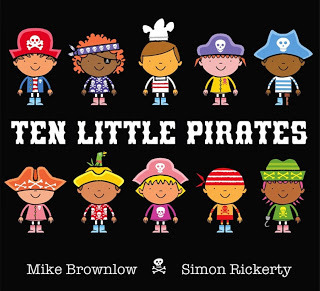
It came unbidden, as sometimes these things do. Walking with my wife in Trelissick Gardens not far from Falmouth, thinking about nothing in particular, the words “Ten little pirates, sailing out to sea, looking for adventure, happy as can be” popped into my head.
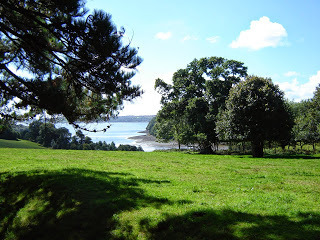
Maybe it was because I was in Cornwall, with all its piratical connections, or maybe because it was a beautiful day and I was gazing out over the sea that the nautical theme occurred to me. Whatever the reason, it might have stayed no more than an opening line, soon forgotten, had I not immediately coupled it to the idea of ten green bottles, and their gradual reduction in number.
So, here we have ten little pirates ready to be bumped off one by one in a series of nautical mishaps, the more dramatic the better. But would this be too gruesome for a picture book text aimed at 3-6 year olds? Well not if a happy ending could be arranged, and I had an idea about that. By the time we’d finished our walk I reckon I had about a third of the book written. I dragged my wife into the National Trust coffee shop, and she patiently waited until I'd put down on paper what was in my head. It felt like a strong idea, but I've grown to be wary of first ideas. I’ve started on texts before now, thinking yay! this is the one! – a terrific idea that will make for a sure-fire best seller, only to realize a little later that maybe that first flush of enthusiasm was misplaced.
But another feeling I've learnt to trust is to make time to develop that germ of an idea, whether the outcome is a good manuscript or a duff one. And do it as quickly as you can manage. I made time the next day and pretty soon I had the first draft of Ten Little Pirates done and dusted. It happened that I was quite busy with other work at the time. I was illustrating a book for America, and was running a bit behind schedule. I had a pretty good idea how I wanted my pirates to look - a bunch of disreputable but lovable rogues, with the odd scar and peg leg thrown in to conform to piratical convention. I doodled about, but the annoying thing was that I couldn't actually get down to roughing out the pictures for the book because of pressure of work.
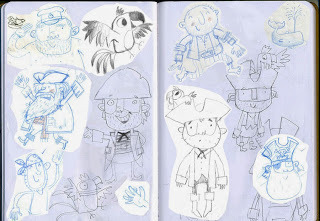
Yet there was still that nagging feeling - was the idea any good? If you're anything like me, confidence is brittle at best, no matter how many books you've had published. I needed confirmation that my text was on the right track. I needed that reassuring pat on the shoulder. So I sent the manuscript off to my agent without any accompanying sample illustration, nor even a pencil character rough, and went back to my other work. All I wanted was a little note saying, yes, this is good, carry on, or no, I don't think this is going to fly.
In the evenings over the next few days I worked on the look of my pirates, and even did a painting of them hanging from the rigging. I was keen to continue, but the Americans were sending me nagging emails, so it was back to the day job.
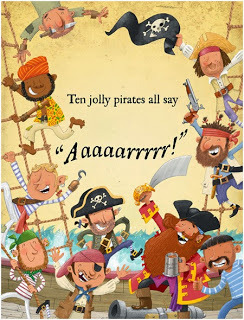
Less than two weeks later I received an email from Caroline Walsh, my agent at David Highams. 'Congratulations!' it said, “Orchard Books have made an offer on Ten Little Pirates!” Orchard are better than good. They're a great publisher responsible for producing many lovely books. I was thrilled... until I read the next sentence. “And they have the perfect illustrator for the book.” The 'perfect illustrator' it turned out, wasn't me. Orchard had worked before with a young, relatively new artist called Simon Rickerty. He had produced a book for them, 'Suddenly', and it was doing very well. They'd been looking for another text for him to work on and, in their opinion, this was it.
I'll confess it. I was miffed. I huffed about for a while until I'd collected my thoughts. I made the fateful decision. I emailed Caroline to say thanks but no thanks. I really want to illustrate this one myself. Terribly sorry and everything. Caroline emailed me back to say “Er, are you really sure about that? This is a great deal they're offering.” I had another think. I had, I realized, done most of the hard writing work by this time. Illustrating it would take me at least another three, probably four months of hard graft. I checked up on the upstart Rickerty. Damn. He was very good. Bright, bold, strong shapes. A charming naïvety juxtaposed with graphic sophistication. Was this worth having a hissy fit about? I was being offered the opportunity of a book deal with the prospect of having very little extra work to do. All the rest of the hard slog would be down to Simon.
I recanted. I said yes to the deal. It turned out that my manuscript had landed on the desk of Frances Elks, who had been newly promoted to editor that very week. She has subsequently told me that she was worried at the time because people had warned her it might take weeks before she saw a promising manuscript, and here she was, on the first morning of her first day, with something sitting in front of her that she thought was really good. It had apparently taken the reassurance of one or two of her colleagues before she’d followed her convictions and made the offer, but I'll always be grateful that she did.
Fran very kindly suggested she show me Simon's work as it progressed to see if I had any comments. My old illustrator instincts getting the better of me, I looked over his roughs and actually, yes, I did have one or two thoughts. Shouldn't that giant squid be a bit more terrifying? Shouldn't the pirates be in a bit more of a panic on that other spread? Shouldn't that pirate's hair be a teensiest bit browner? Whether Simon actually saw any of my comments I don't know. If he did, he politely ignored most of them and went his own way. And why not? I always hate it when art directors come back to me with nit-picking amendments. I decided to keep any future comments to a minimum. I needn't have worried. Simon did a beautiful job with my little pirates, taking the ‘Little’ part of the title literally and coming up with ten child-like pirates, whose look seems to chime well with children.
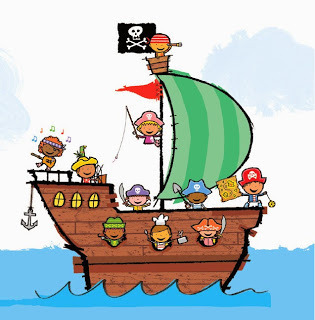
Ten Little Pirates breaks two big rules – it’s written in rhyme and its cover is black. Despite this I'm happy to say that at the time of writing the book is selling really well, with five reprints of the paperback in less than two months. It’s also been short-listed for two literary awards. Orchard are so pleased that they’re making it into a series. The next one out is Ten Little Princesses, in August. There are two more ordered, and I’ve just completed the first of those scripts, which personally, I think is the best one yet. (Dinosaurs since you ask!)
More by accident than design, Ten Little Pirates has turned out to be a great book to read out at school visits. Some books make for a quiet read. Not TLPs. I always get the children to stand up and join in with the actions and the noises that accompany the story, and it seems to work a treat. Having a hall full of children leaping into the air and all crying out “ARRRRR!!! at the top of their voices is very satisfying. It even works with a room full of jolly, middle-aged women as I found out the other week when I gave a talk to a regional branch of a book charity in a library.
Hachette, who own Orchard, have a brilliant publicity department, and Rebecca Hearne who deals with me, has found me lots of spots at various festivals, something I’ve done very little of before. It feels very good indeed to have a publisher’s support like this.
And illustrating? Well it’s fair to say I’ve had a bit of a crisis in confidence with my illustration. I know many illustrators and lots of us periodically reach a stage when the work we’re producing feels tired and dull. (A browse through the picture book section of any bookshop usually brings on this feeling in me!) But after a relatively fallow period last year, I’ve re-evaluated things and have updated my way of working in a way that makes me feel enthusiastic about the future. I’ve been doing some pared down illustrations and it feels more contemporary. ‘Less is more’ is a motto I’ve always admired, but never had the courage to put into practice. Now I feel I’ve tweaked my paintings so that the results look less fussy.
But the real discovery from my decision to hand over the illustrating reins to someone else, is that I haven’t missed illustrating nearly as much as I thought I would. In fact I’ve spent quite a lot more time recently writing other manuscripts – early reader and middle grade books as well as picture book texts – and I’ve found that to be a thrilling and addictive process.
So, am I pleased I decided to let another artist illustrate my text? Very definitely ARRRRRRR!!
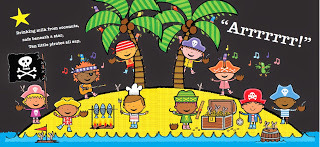

It came unbidden, as sometimes these things do. Walking with my wife in Trelissick Gardens not far from Falmouth, thinking about nothing in particular, the words “Ten little pirates, sailing out to sea, looking for adventure, happy as can be” popped into my head.

Maybe it was because I was in Cornwall, with all its piratical connections, or maybe because it was a beautiful day and I was gazing out over the sea that the nautical theme occurred to me. Whatever the reason, it might have stayed no more than an opening line, soon forgotten, had I not immediately coupled it to the idea of ten green bottles, and their gradual reduction in number.
So, here we have ten little pirates ready to be bumped off one by one in a series of nautical mishaps, the more dramatic the better. But would this be too gruesome for a picture book text aimed at 3-6 year olds? Well not if a happy ending could be arranged, and I had an idea about that. By the time we’d finished our walk I reckon I had about a third of the book written. I dragged my wife into the National Trust coffee shop, and she patiently waited until I'd put down on paper what was in my head. It felt like a strong idea, but I've grown to be wary of first ideas. I’ve started on texts before now, thinking yay! this is the one! – a terrific idea that will make for a sure-fire best seller, only to realize a little later that maybe that first flush of enthusiasm was misplaced.
But another feeling I've learnt to trust is to make time to develop that germ of an idea, whether the outcome is a good manuscript or a duff one. And do it as quickly as you can manage. I made time the next day and pretty soon I had the first draft of Ten Little Pirates done and dusted. It happened that I was quite busy with other work at the time. I was illustrating a book for America, and was running a bit behind schedule. I had a pretty good idea how I wanted my pirates to look - a bunch of disreputable but lovable rogues, with the odd scar and peg leg thrown in to conform to piratical convention. I doodled about, but the annoying thing was that I couldn't actually get down to roughing out the pictures for the book because of pressure of work.

Yet there was still that nagging feeling - was the idea any good? If you're anything like me, confidence is brittle at best, no matter how many books you've had published. I needed confirmation that my text was on the right track. I needed that reassuring pat on the shoulder. So I sent the manuscript off to my agent without any accompanying sample illustration, nor even a pencil character rough, and went back to my other work. All I wanted was a little note saying, yes, this is good, carry on, or no, I don't think this is going to fly.
In the evenings over the next few days I worked on the look of my pirates, and even did a painting of them hanging from the rigging. I was keen to continue, but the Americans were sending me nagging emails, so it was back to the day job.

Less than two weeks later I received an email from Caroline Walsh, my agent at David Highams. 'Congratulations!' it said, “Orchard Books have made an offer on Ten Little Pirates!” Orchard are better than good. They're a great publisher responsible for producing many lovely books. I was thrilled... until I read the next sentence. “And they have the perfect illustrator for the book.” The 'perfect illustrator' it turned out, wasn't me. Orchard had worked before with a young, relatively new artist called Simon Rickerty. He had produced a book for them, 'Suddenly', and it was doing very well. They'd been looking for another text for him to work on and, in their opinion, this was it.
I'll confess it. I was miffed. I huffed about for a while until I'd collected my thoughts. I made the fateful decision. I emailed Caroline to say thanks but no thanks. I really want to illustrate this one myself. Terribly sorry and everything. Caroline emailed me back to say “Er, are you really sure about that? This is a great deal they're offering.” I had another think. I had, I realized, done most of the hard writing work by this time. Illustrating it would take me at least another three, probably four months of hard graft. I checked up on the upstart Rickerty. Damn. He was very good. Bright, bold, strong shapes. A charming naïvety juxtaposed with graphic sophistication. Was this worth having a hissy fit about? I was being offered the opportunity of a book deal with the prospect of having very little extra work to do. All the rest of the hard slog would be down to Simon.
I recanted. I said yes to the deal. It turned out that my manuscript had landed on the desk of Frances Elks, who had been newly promoted to editor that very week. She has subsequently told me that she was worried at the time because people had warned her it might take weeks before she saw a promising manuscript, and here she was, on the first morning of her first day, with something sitting in front of her that she thought was really good. It had apparently taken the reassurance of one or two of her colleagues before she’d followed her convictions and made the offer, but I'll always be grateful that she did.
Fran very kindly suggested she show me Simon's work as it progressed to see if I had any comments. My old illustrator instincts getting the better of me, I looked over his roughs and actually, yes, I did have one or two thoughts. Shouldn't that giant squid be a bit more terrifying? Shouldn't the pirates be in a bit more of a panic on that other spread? Shouldn't that pirate's hair be a teensiest bit browner? Whether Simon actually saw any of my comments I don't know. If he did, he politely ignored most of them and went his own way. And why not? I always hate it when art directors come back to me with nit-picking amendments. I decided to keep any future comments to a minimum. I needn't have worried. Simon did a beautiful job with my little pirates, taking the ‘Little’ part of the title literally and coming up with ten child-like pirates, whose look seems to chime well with children.

Ten Little Pirates breaks two big rules – it’s written in rhyme and its cover is black. Despite this I'm happy to say that at the time of writing the book is selling really well, with five reprints of the paperback in less than two months. It’s also been short-listed for two literary awards. Orchard are so pleased that they’re making it into a series. The next one out is Ten Little Princesses, in August. There are two more ordered, and I’ve just completed the first of those scripts, which personally, I think is the best one yet. (Dinosaurs since you ask!)
More by accident than design, Ten Little Pirates has turned out to be a great book to read out at school visits. Some books make for a quiet read. Not TLPs. I always get the children to stand up and join in with the actions and the noises that accompany the story, and it seems to work a treat. Having a hall full of children leaping into the air and all crying out “ARRRRR!!! at the top of their voices is very satisfying. It even works with a room full of jolly, middle-aged women as I found out the other week when I gave a talk to a regional branch of a book charity in a library.
Hachette, who own Orchard, have a brilliant publicity department, and Rebecca Hearne who deals with me, has found me lots of spots at various festivals, something I’ve done very little of before. It feels very good indeed to have a publisher’s support like this.
And illustrating? Well it’s fair to say I’ve had a bit of a crisis in confidence with my illustration. I know many illustrators and lots of us periodically reach a stage when the work we’re producing feels tired and dull. (A browse through the picture book section of any bookshop usually brings on this feeling in me!) But after a relatively fallow period last year, I’ve re-evaluated things and have updated my way of working in a way that makes me feel enthusiastic about the future. I’ve been doing some pared down illustrations and it feels more contemporary. ‘Less is more’ is a motto I’ve always admired, but never had the courage to put into practice. Now I feel I’ve tweaked my paintings so that the results look less fussy.
But the real discovery from my decision to hand over the illustrating reins to someone else, is that I haven’t missed illustrating nearly as much as I thought I would. In fact I’ve spent quite a lot more time recently writing other manuscripts – early reader and middle grade books as well as picture book texts – and I’ve found that to be a thrilling and addictive process.
So, am I pleased I decided to let another artist illustrate my text? Very definitely ARRRRRRR!!

Published on April 21, 2014 16:47
April 15, 2014
There Are Two Types of Picture Book - by Jonathan Allen
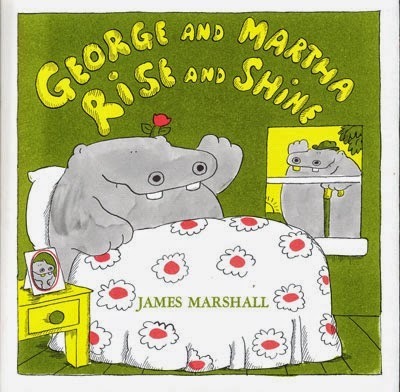
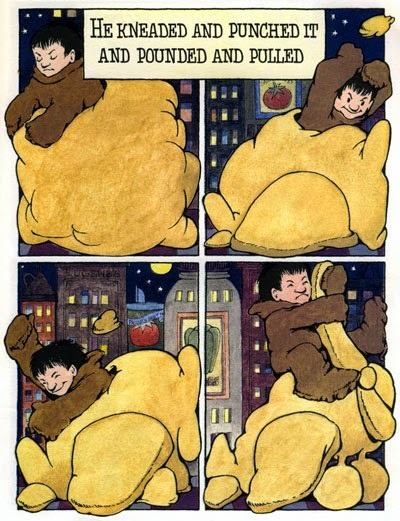
It's something that I realised a long time ago but never tried to define. That for me at any rate, children's books, and especially illustrated children's books fall broadly into two camps with two different functions - Funny, and what I shall call, for want of a better word, (though I'm sure one exists and I will think of it the second after I press 'publish') 'Transporting' books. Funny books are made with the purpose of generating laughs, obviously, and 'Transporting' ones are made with the idea of taking you into another place or world for a brief time.
The illustrations have a huge role to play in this of course, and the way the Funny v 'Transporting' thing works in the visual field.
Funny deals in simple 'reduced to the essence' line drawings, in character and stance, details aren't important, as immersion in a created world is not in it's remit. Funny deals with the already familiar. Not necessarily familiar surroundings but familiar situations. Surroundings only ever need to be suggested.
'Transporting' deals in complexity and detail. Detail is important for believability, the more detail (up to a point) the more the possibility of successful immersion in the world created. I put books where the creation of a certain mood is important into this category. Funny doesn't really deal in mood creation.
The interesting thing about this split, to me, is the attitude of the public towards each camp. There is some of the time honoured (and unexamined) respect shown to work that betrays obvious evidence of hard work and 'skill'. But that is to be expected, unfortunately. Putting that aside, it does seem that work that speaks to perhaps a deeper place in their hearts and minds lingers longer in the public imagination than work which 'merely' amuses.
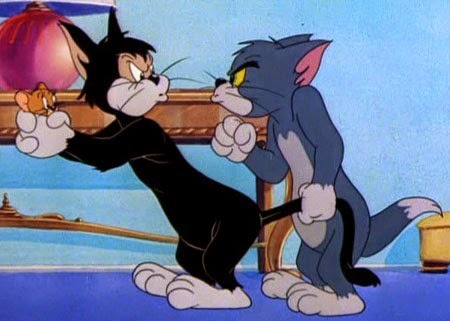
I have always thought that this was a bit sad, as a lifelong fan of Tom and Jerry, and The Beano, and books by people like James Marshall, I feel that they, and other work in the same vein will always be under rated in as far as bestowed 'greatness' goes. Probably because it deals with small, familiar situations and with humour, which is never considered all that 'important', or particularly hard to do. A bit like Picture Books ;-)
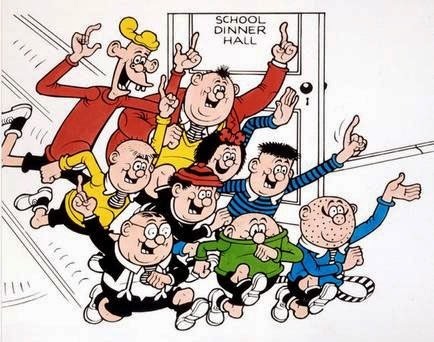
The other thing I realised at about the same time was that illustrated children's books that get onto any list of all time greats in the field will be largely from the 'transporting' camp.
'Where The Wild Things Are', 'Winnie The Pooh', 'Peter Rabbit', 'The Tiger Who Came to Tea' 'The Snowman'. 'Tim All Alone' etc.
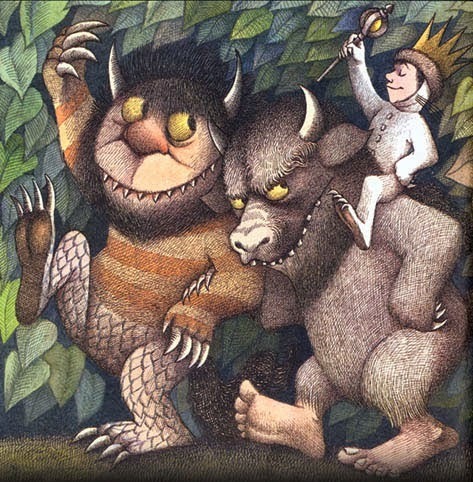
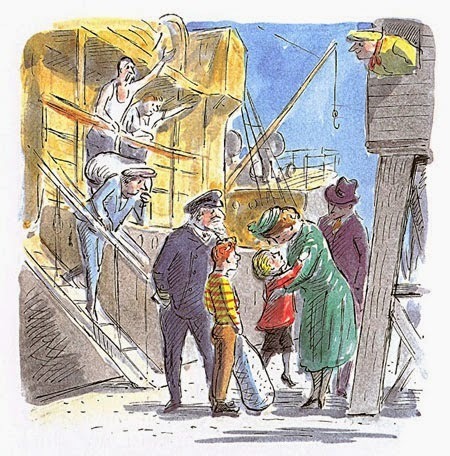
The interesting thing is that I can't as readily name a list of great funny picture books. I tend to think in terms of illustrators rather than in terms of actual titles. Artists such as Quentin Blake, James Marshall, Jon Klaasen, Tony Ross, Colin West, though much loved, would never top any 'best of all time' lists though they may come close. I think this is because once something is laughed at or with, it is perceived as being of lesser value than something 'serious', even if that perception is entirely unconscious.
Dr Suess may be the exception, but head to head with Sendak? There's a contest! ;-)
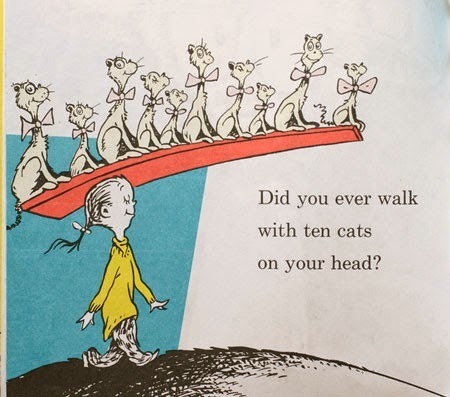
Published on April 15, 2014 00:14
There Are Two Types of Picture Book


It's something that I realised a long time ago but never tried to define. That for me at any rate, children's books, and especially illustrated children's books fall broadly into two camps with two different functions - Funny, and what I shall call, for want of a better word, (though I'm sure one exists and I will think of it the second after I press 'publish') 'Transporting' books. Funny books are made with the purpose of generating laughs, obviously, and 'Transporting' ones are made with the idea of taking you into another place or world for a brief time.
The illustrations have a huge role to play in this of course, and the way the Funny v 'Transporting' thing works in the visual field.
Funny deals in simple 'reduced to the essence' line drawings, in character and stance, details aren't important, as immersion in a created world is not in it's remit. Funny deals with the already familiar. Not necessarily familiar surroundings but familiar situations. Surroundings only ever need to be suggested.
'Transporting' deals in complexity and detail. Detail is important for believability, the more detail (up to a point) the more the possibility of successful immersion in the world created. I put books where the creation of a certain mood is important into this category. Funny doesn't really deal in mood creation.
The interesting thing about this split, to me, is the attitude of the public towards each camp. There is some of the time honoured (and unexamined) respect shown to work that betrays obvious evidence of hard work and 'skill'. But that is to be expected, unfortunately. Putting that aside, it does seem that work that speaks to perhaps a deeper place in their hearts and minds lingers longer in the public imagination than work which 'merely' amuses.

I have always thought that this was a bit sad, as a lifelong fan of Tom and Jerry, and The Beano, and books by people like James Marshall, I feel that they, and other work in the same vein will always be under rated in as far as bestowed 'greatness' goes. Probably because it deals with small, familiar situations and with humour, which is never considered all that 'important', or particularly hard to do. A bit like Picture Books ;-)

The other thing I realised at about the same time was that illustrated children's books that get onto any list of all time greats in the field will be largely from the 'transporting' camp.
'Where The Wild Things Are', 'Winnie The Pooh', 'Peter Rabbit', 'The Tiger Who Came to Tea' 'The Snowman'. 'Tim All Alone' etc.


The interesting thing is that I can't as readily name a list of great funny picture books. I tend to think in terms of illustrators rather than in terms of actual titles. Artists such as Quentin Blake, James Marshall, Jon Klaasen, Tony Ross, Colin West, though much loved, would never top any 'best of all time' lists though they may come close. I think this is because once something is laughed at or with, it is perceived as being of lesser value than something 'serious', even if that perception is entirely unconscious.
Dr Suess may be the exception, but head to head with Sendak? There's a contest! ;-)

Published on April 15, 2014 00:14
April 10, 2014
Throwing Out Old Picture Books by Paeony Lewis
This week it’s the London Book Fair, where many new picture books are unveiled. That’s wonderful. However, I'm in a retrospective mood because I've been moving old books out of the reach of my dog’s hungry jaws (unfortunately, ancient horse glue is yummy). I've even been debating throwing out some old books.
I don't care about these three books:
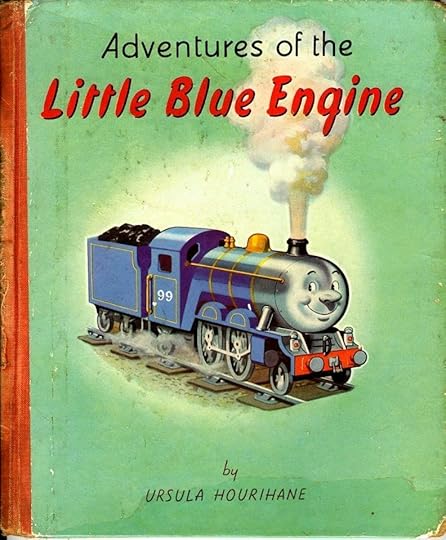


But I want to keep these three books:
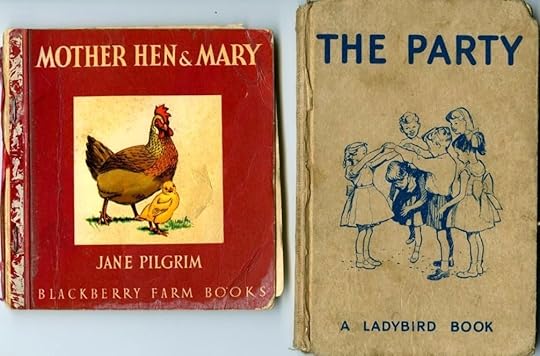

Why?
For me, it’s the memories trapped in old picture books that are important. I think that books are like photographs – we often forget the past until we see photographs or 'important' books. They’re a catalyst for memories.
So why not keep the first three books? Being a bit of a hoarder I suspect I will leave them on the shelf, but I have no emotional attachment to them. They evoke no memories and I feel uncomfortable with the Teddy Bear Picture Book (for obvious reasons). By the way, I've just noticed all three unwanted books include trains, so I can’t have been a big fan of engines!
Instead, I prefer to keep slightly embarrassing books like The Party. Good grief, what’s wrong with me?! Nowadays people mock these ‘Susan and John’ Ladybird books. Ho hum, at the time I adored this book. There were party dresses, cake, games and shiny patent leather shoes (or in my case, shiny plastic party shoes that quickly became too small). Going to a party was EXCITING! I liked looking at the pictures and on many pages I tried writing letters (and failed).

Then there’s My Book of Kittens and Puppies that even my mother disliked. Well, despite another dubious cover, I thought this book from my grandma was wonderful. Where else would I see things like cute dogs and cats getting married? Great!

Yikes, I've just realised I'm disinterested in books that include train engines, yet I want to keep girly books about parties, animals in cute clothes, and a naughty little chick who drives her mummy to distraction (Mother Hen & Mary), but what the chick really wants is to grow into a big hen like Mummy and lay eggs. Sigh. It sounds like I was a real girly girl, but I also loved dinosaurs, playing with my toy garage and cars, and was so excited when my dad let me use an air gun. However, the girl/boy debate is not the aim of this blog.
So what’s the point of this blog, apart from being a blast from the past? I suppose it’s a plea to not throw out your children’s old picture books without asking them what they’d like to keep (and then listening to them!). I believe picture books are an important part of childhood. Some images stay in the memory forever and stories can have a strong emotional resonance.
When I was five I was given British Fairy Tales (Amabel Williams-Ellis) and I've never forgotten the magical dancing beneath the hill (especially when I visited Glastonbury Tor, twenty years later!).

Unfortunately though, some books evoke slightly sadder memories. My heart would break for the lonely donkey in Little Grey Donkey (Alice Lunt/Tibor Gergely). Whilst I enjoyed Little Bear playing with Father Bear in Good Night Little Bear (Patsy Scarry/Richard Scarry), but I always felt sad that my mummy didn't get on with my daddy as well as Father Bear and Mother Bear. So should I throw out these books and forget? I don’t know.

 I often hear of adults buying new editions of old books because their parents have thrown away a childhood book that meant a lot to them, but the parents didn't know. Sadly, it’s never the same as the original. I smile when I see my mother's colouring in of her Winnie the Pooh book. A book may be torn and covered in scribbles, or may be of debatable literary worth, but who cares about this if it also cradles important memories? Or am I just a hoarder? What do you think?
I often hear of adults buying new editions of old books because their parents have thrown away a childhood book that meant a lot to them, but the parents didn't know. Sadly, it’s never the same as the original. I smile when I see my mother's colouring in of her Winnie the Pooh book. A book may be torn and covered in scribbles, or may be of debatable literary worth, but who cares about this if it also cradles important memories? Or am I just a hoarder? What do you think?
Paeony Lewis
www.paeonylewis.com
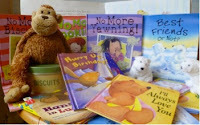
I don't care about these three books:



But I want to keep these three books:


Why?
For me, it’s the memories trapped in old picture books that are important. I think that books are like photographs – we often forget the past until we see photographs or 'important' books. They’re a catalyst for memories.
So why not keep the first three books? Being a bit of a hoarder I suspect I will leave them on the shelf, but I have no emotional attachment to them. They evoke no memories and I feel uncomfortable with the Teddy Bear Picture Book (for obvious reasons). By the way, I've just noticed all three unwanted books include trains, so I can’t have been a big fan of engines!
Instead, I prefer to keep slightly embarrassing books like The Party. Good grief, what’s wrong with me?! Nowadays people mock these ‘Susan and John’ Ladybird books. Ho hum, at the time I adored this book. There were party dresses, cake, games and shiny patent leather shoes (or in my case, shiny plastic party shoes that quickly became too small). Going to a party was EXCITING! I liked looking at the pictures and on many pages I tried writing letters (and failed).

Then there’s My Book of Kittens and Puppies that even my mother disliked. Well, despite another dubious cover, I thought this book from my grandma was wonderful. Where else would I see things like cute dogs and cats getting married? Great!

Yikes, I've just realised I'm disinterested in books that include train engines, yet I want to keep girly books about parties, animals in cute clothes, and a naughty little chick who drives her mummy to distraction (Mother Hen & Mary), but what the chick really wants is to grow into a big hen like Mummy and lay eggs. Sigh. It sounds like I was a real girly girl, but I also loved dinosaurs, playing with my toy garage and cars, and was so excited when my dad let me use an air gun. However, the girl/boy debate is not the aim of this blog.
So what’s the point of this blog, apart from being a blast from the past? I suppose it’s a plea to not throw out your children’s old picture books without asking them what they’d like to keep (and then listening to them!). I believe picture books are an important part of childhood. Some images stay in the memory forever and stories can have a strong emotional resonance.
When I was five I was given British Fairy Tales (Amabel Williams-Ellis) and I've never forgotten the magical dancing beneath the hill (especially when I visited Glastonbury Tor, twenty years later!).

Unfortunately though, some books evoke slightly sadder memories. My heart would break for the lonely donkey in Little Grey Donkey (Alice Lunt/Tibor Gergely). Whilst I enjoyed Little Bear playing with Father Bear in Good Night Little Bear (Patsy Scarry/Richard Scarry), but I always felt sad that my mummy didn't get on with my daddy as well as Father Bear and Mother Bear. So should I throw out these books and forget? I don’t know.

 I often hear of adults buying new editions of old books because their parents have thrown away a childhood book that meant a lot to them, but the parents didn't know. Sadly, it’s never the same as the original. I smile when I see my mother's colouring in of her Winnie the Pooh book. A book may be torn and covered in scribbles, or may be of debatable literary worth, but who cares about this if it also cradles important memories? Or am I just a hoarder? What do you think?
I often hear of adults buying new editions of old books because their parents have thrown away a childhood book that meant a lot to them, but the parents didn't know. Sadly, it’s never the same as the original. I smile when I see my mother's colouring in of her Winnie the Pooh book. A book may be torn and covered in scribbles, or may be of debatable literary worth, but who cares about this if it also cradles important memories? Or am I just a hoarder? What do you think?Paeony Lewis
www.paeonylewis.com

Published on April 10, 2014 00:00
April 4, 2014
Can You See Me Now? By Pippa Goodhart
Back in February, the wonderful Imagine! Festival for children ran in the Royal Festival Hall on London’s South Bank. I was involved in a small way with the part of that festival run by the Inclusive Minds collective. As the name implies, their session was all about making books and stories accessible to all sorts of children, and making sure that books for children include every sort of child and children from all sorts of backgrounds. It was a wonderful day of sensory stories, signed poetry, a huge wall on which all could draw themselves (or anything they fancied), some serious adult debate, and a lot of story sharing, drawing, chatter and fun. And it set me thinking.
 It is, of course, important to include children of all races, from all sorts of cultural backgrounds, and those with disabilities, naturally within picture books; representing all of us without exclusion. Nick Sharratt has managed to include a number of children with visual clues to particular conditions in our’ Just Imagine’ book’s busy pictures.
It is, of course, important to include children of all races, from all sorts of cultural backgrounds, and those with disabilities, naturally within picture books; representing all of us without exclusion. Nick Sharratt has managed to include a number of children with visual clues to particular conditions in our’ Just Imagine’ book’s busy pictures. But the What About Me? event stated that, ‘the organisers believe that ALL children should be able to see themselves, their lives, their friends and their families represented in the stories and pictures they are given.’ But I wonder if there isn’t a danger that that idea might be taken too literally? Does that mean that a boy with ginger hair who wears a hearing aid won’t see himself in a picture of a black haired girl wearing a hearing aid? Do we really want to see ourselves exactly in books? If so, books will have to be tailor-made for each reader … and I, for one, DON’T want to read about, or see, a story about a plump middle-aged woman with scruffy hair who writes stories for children! I want other experiences, beyond my own real ones, when I read. But I DO want to find emotional states in stories that I recognise and want to explore. It’s at that gut feeling level that I find the point of contact between myself and a story.
But the What About Me? event stated that, ‘the organisers believe that ALL children should be able to see themselves, their lives, their friends and their families represented in the stories and pictures they are given.’ But I wonder if there isn’t a danger that that idea might be taken too literally? Does that mean that a boy with ginger hair who wears a hearing aid won’t see himself in a picture of a black haired girl wearing a hearing aid? Do we really want to see ourselves exactly in books? If so, books will have to be tailor-made for each reader … and I, for one, DON’T want to read about, or see, a story about a plump middle-aged woman with scruffy hair who writes stories for children! I want other experiences, beyond my own real ones, when I read. But I DO want to find emotional states in stories that I recognise and want to explore. It’s at that gut feeling level that I find the point of contact between myself and a story.

I think we’re in danger of forgetting the power of imagination in all this, and I’d suggest that picture books with animal characters are a great way to avoid all those visual mis-match problems whilst getting to the emotional heart of the matter.
For some reason it’s easier to identify with a fictional character who looks totally unlike us than it is to identify with a character who is human, but different from us in age or sex or appearance or background. So we all sympathise with lovely elephant Elmer’s insecurity in the happy story about him by David McKee in which patchwork Elmer attempts to blend in with the grey elephants. A similar story about a child with, for example, a walking frame, who tried to get rid of the walking frame so as to look like the other children, would tend to be a very uncomfortable and unhappy read. Elmer does a better job than a human character could in making us realise how it might be difficult to be different, and the need for others to consider and do something about that difficulty … in this case by having an Elmer Day once a year when all the elephants paint themselves fancy colours.
 There are picture books with animal characters which more obviously tackle a specific disability. Jeanne Willis and Sarah Fox-Davies’ ‘Mole’s Sunrise’ is a very beautiful book in which blind Mole’s kind friends take him to ‘see’ the sun rise, and describe what they see so as to share that visual experience with Mole.
There are picture books with animal characters which more obviously tackle a specific disability. Jeanne Willis and Sarah Fox-Davies’ ‘Mole’s Sunrise’ is a very beautiful book in which blind Mole’s kind friends take him to ‘see’ the sun rise, and describe what they see so as to share that visual experience with Mole. Yes, we certainly do need children of all sorts included in picture books, but please don’t forget the richness of what is already out there in stories that on the surface are about animals, but at heart are all about human emotions and experiences.
Have you got other picture book examples you would recommend, featuring examples of anthropomorphic characters whose experiences might chime with disabled or marginalised children?
Published on April 04, 2014 16:01
March 31, 2014
A writing process described
Moira Butterfield
www.moirabutterfield.com
@moiraworld
 A cover from the work in progress described below.
A cover from the work in progress described below. “I like your story. When I read it, it’s like a movie in my head.” That was part of a lovely email sent to me by a young US reader this week, and I was delighted with the phrase she used because it struck a chord with me, and made me think about my work process. I work on books for all ages and in several genres. Whether I’m working on story material, non-fiction or practical make-and-do ideas. I’m doing my best to take my reader on a journey, and to do that I’m trying to imagine what effect the words and images are going to have. If my reader can ‘see a movie’ in their head, I’ve succeeded. This chimes with something I’ve been working on in the last few weeks, so I thought I’d share the work process on the project, because it’s a particularly lively one. By-the-by, it’s also a peek into a different kind of author commission – intensive, fast and team-led – rather than picture book texts that develop over time without a specific brief. However, there are similarities. The brief I’m going to explore came from an educational publisher Wayland. They wanted a series for children who are in the very first years of school (and who would therefore still respond to a picture book approach). For the visuals we had to use existing photography from photo-libraries where possible, combined in some way with backgrounds. The subject of the series was to be ‘my feelings’. The feelings were already chosen – When I’m - sad, angry, surprised, happy. The size was set – 210 x 210mm, 24pp. Now it was down to me to think of a way to do it (and do it very fast!). The first step I took was to get out my sketchbook, and I began to think and to doodle ideas. What would a child think about being angry or being sad? How could words and pictures help them to think about it? How could I create books that were helpful and positive but not moralizing and patronising? How would the books work in a classroom or with a parent? I didn’t think of all these questions at once. They came to me as I mused and doodled and, crucially, when I started running mini movies in my head imagining children using the books. I guess I started to imagine myself as a child. Yes, that sounds a little weird, and I do occasionally wonder if I am, in fact, crazy when I do this – But then I think most authors must probably feel this way at times. I soon realized that I wanted a great deal of fun in the ‘feeling’ books, and I wanted lively imaginative action – such as feeling angry enough to blow up like a volcano, making a face angry enough to scare monsters or feeling angry enough to bellow like an elephant.

 Rough sketches and scribbles for 'Angry'Each book needed to be crafted to create a strong shared experience and give opportunities for role-playing. Above all they needed to be fun. That approach could only work if we combined the photographs with very lively graphics.
Rough sketches and scribbles for 'Angry'Each book needed to be crafted to create a strong shared experience and give opportunities for role-playing. Above all they needed to be fun. That approach could only work if we combined the photographs with very lively graphics.
 Here's me playing about with ideas for an 'angry' contents page (and repeating myself!).
Here's me playing about with ideas for an 'angry' contents page (and repeating myself!). Soon I was writing, sketching and selecting a range of possible photos, and luckily I found I was working with a fantastic design/illustrator team at Rocket Design in East Anglia. They really ‘got’ my ideas, ran with them and made them work.

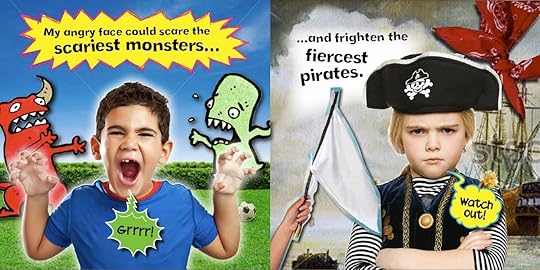 The designers took my text, sketches and photo suggestions and made them dynamic.
The designers took my text, sketches and photo suggestions and made them dynamic. After writing an initial draft of the first book I realized that I needed to add more interactivity. I added extra words that children could say, such as ‘pop’ or ‘boom’, that could be integrated into the visuals. I wanted my young readers to really start acting and to have a laugh whilst thinking about themselves! I even added a whole acting spread at the back.
 An 'acting' spread in the process of being designed (the text relates to the rest of the book)
An 'acting' spread in the process of being designed (the text relates to the rest of the book)The words needed to be rhythmic so that they were easily and satisfyingly read aloud (perhaps by a teacher to a whole class, or by a child to a reading mentor). They had to get across the meaning, obviously, and also give the designers opportunities for those lively graphics. Of course, the text evolved as it went along, and I went down one or two wrong routes and had to reverse: “Is angry really the right emotion for stubbing a toe? Hmm…Now I come to think of it, probably not. I’d be more likely to blub.” The whole project sounds a bit complicated when written down, but it was mostly intuitive. However, it only gelled because I made sure I constantly thought of the child who was my reader. It’s the same technique I would use for any age-group or children’s book genre I was working on. It sounds quite intense, and does feel intense. For any genre, I'm putting in maximum effort and thought.
The thinking process would be similar in a picture book, but then one would have the time and space to go in any direction, unfettered. You might make a mood board, perhaps, or simply sit and play with words. You’d be unlikely to send sketches with your story, but perhaps you might do a few privately to help you think about a character. I’d be interested to hear. Do you perhaps run a movie in your head, then change it and follow different paths? And do you feel a bit crazy sometimes? Is it, at times, a very intense experience?
Perhaps I should do another ‘feelings’ book especially for authors: ‘When I’m creating...’!
 Cover designsPS: the books are still being worked on and haven’t gone to press yet. Many thanks to Debbie Foy and Steve White-Thompson for agreeing to let me write about the project.
Cover designsPS: the books are still being worked on and haven’t gone to press yet. Many thanks to Debbie Foy and Steve White-Thompson for agreeing to let me write about the project.
Published on March 31, 2014 00:00
March 25, 2014
Tear-jerkers: picture books that make you cry by Malachy Doyle
When I read, I want to care about the characters. I want to become emotionally involved with them. I love it when a book makes me laugh out loud. I also love it when a book makes me cry.
Many picture books make you laugh out loud. I've just spent a week with my nearly-two year old grandson, Daniel, and we laughed and laughed. His favourite right now is Ding Dong Gorilla! by a certain Michelle Robinson - it's a scream!
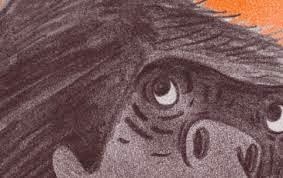
None made him cry, luckily. But picture books are for two audiences - the prime audience, young children, but also the adult who picks it up in the shop or library, and who then shares it with children. It's crucial that the book works for both - and works, therefore, on more than one level.
Some books, which children happily accept as one more enjoyable story, somehow have the capacity to reduce adults to quivering wrecks. I realised this when a very kind reader responded to a previous blog post about my book The Dancing Tiger.
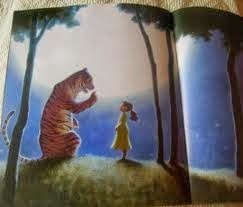
'Five years and two daughters on and after hundreds of attempts,' she told me, 'I am yet to actually finish the story. My noise twitches when I pick it up, it stings on the opening line and the tears are flooding at ‘But now that I am old and grey...'
Luckily it hadn't put her off. 'I have discussed this book for hours on end and my sister and I often wonder if you or Steve and Lou (the illustrators)can actually comprehend what you have created. I have ten copies ready to pass to my children and my grandchildren. When my children ask (as they often do), do I believe in magic? I think of your book and gently reassure them that yes I do.'
Isn't that wonderful! It got me thinking about the picture books that have had a similar effect on me. I'm not sure if any have been quite so dramatic, but I'd have no trouble naming some that moved me intensely.
Books about death, if they're done right, are inevitably deeply moving: I'm thinking Frog and the Birdsong, by Max Velthuijs. I'm thinking Badger's Parting Gifts, by Susan Varley.
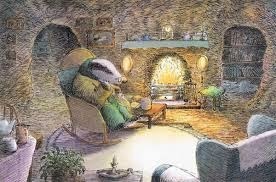
And then there are books that are so beautifully told and illustrated that you just love them, over and over. I'm thinking The Mousehole Cat, by Antonia Barber and Nicola Bayley. I'm thinking Susan Laughs, by Jeanne Willis and Tony Ross. I'm thinking Owl Babies, by Martin Waddell and Patrick Benson. And I'm thinking Dogger - always Dogger. They don't necessarily make me cry, but they move me deeply, every time.
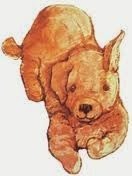
Anyone want to own up to crying at a picture book? Any recommendations for the tear-jerker list? Or just ones that move you deeply. I'd love to read a few more. (And maybe write a few more...)
On that subject, I've a picture book coming out later this year (hopefully) called Tadcu's Bobble Hat. Tadcu means grandfather in Welsh, and that's all I'm saying...
Many picture books make you laugh out loud. I've just spent a week with my nearly-two year old grandson, Daniel, and we laughed and laughed. His favourite right now is Ding Dong Gorilla! by a certain Michelle Robinson - it's a scream!

None made him cry, luckily. But picture books are for two audiences - the prime audience, young children, but also the adult who picks it up in the shop or library, and who then shares it with children. It's crucial that the book works for both - and works, therefore, on more than one level.
Some books, which children happily accept as one more enjoyable story, somehow have the capacity to reduce adults to quivering wrecks. I realised this when a very kind reader responded to a previous blog post about my book The Dancing Tiger.

'Five years and two daughters on and after hundreds of attempts,' she told me, 'I am yet to actually finish the story. My noise twitches when I pick it up, it stings on the opening line and the tears are flooding at ‘But now that I am old and grey...'
Luckily it hadn't put her off. 'I have discussed this book for hours on end and my sister and I often wonder if you or Steve and Lou (the illustrators)can actually comprehend what you have created. I have ten copies ready to pass to my children and my grandchildren. When my children ask (as they often do), do I believe in magic? I think of your book and gently reassure them that yes I do.'
Isn't that wonderful! It got me thinking about the picture books that have had a similar effect on me. I'm not sure if any have been quite so dramatic, but I'd have no trouble naming some that moved me intensely.
Books about death, if they're done right, are inevitably deeply moving: I'm thinking Frog and the Birdsong, by Max Velthuijs. I'm thinking Badger's Parting Gifts, by Susan Varley.

And then there are books that are so beautifully told and illustrated that you just love them, over and over. I'm thinking The Mousehole Cat, by Antonia Barber and Nicola Bayley. I'm thinking Susan Laughs, by Jeanne Willis and Tony Ross. I'm thinking Owl Babies, by Martin Waddell and Patrick Benson. And I'm thinking Dogger - always Dogger. They don't necessarily make me cry, but they move me deeply, every time.

Anyone want to own up to crying at a picture book? Any recommendations for the tear-jerker list? Or just ones that move you deeply. I'd love to read a few more. (And maybe write a few more...)
On that subject, I've a picture book coming out later this year (hopefully) called Tadcu's Bobble Hat. Tadcu means grandfather in Welsh, and that's all I'm saying...
Published on March 25, 2014 17:00
March 23, 2014
Turning Black and White into Colour: Creative Nonfiction Picture Books ... and Chocolate by Juliet Clare Bell
 George Cadbury aged about 20 (c) Cadbury Archive.
George Cadbury aged about 20 (c) Cadbury Archive.I’ve fallen in love, and I’m having a whirlwind romance with [cue page turn]...
Creative nonfiction picture books.
Creative nonfiction picture books are simply picture books where the story happens to be true. Sounds really simple but it took me a while to work out that’s what I wanted to do...
I’d thought about writing non-fiction for younger children before. But the passion wasn’t there. I love picture books. I love the way the words and pictures are so much more together than they are separately. I love the drama that can be created in such a short space. I love the form and the constraints.
There was plenty of really interesting information in the nonfiction books I was looking at...
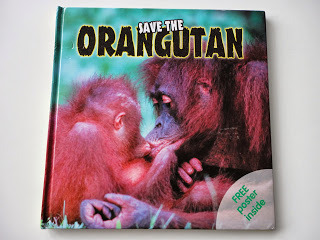 Save The Orangutan (c) Sarah Eason, Powerkids Press.
Save The Orangutan (c) Sarah Eason, Powerkids Press.They felt very educational –which isn’t a criticism at all. I love learning and I was enjoying reading them but they didn't make me want to write them (like good picture books do). So I shelved the idea of writing nonfiction until something that really grabbed me turned up. Then one day ... [cue page turn]
Something that really grabbed me turned up.
An illustrator friend, Jess Mikhail, and I were both approached by Bournville Village Trust, in Birmingham, UK. Would we consider writing and illustrating a picture book together about Bournville? This is where the Cadbury brothers built their famous chocolate factory in the late nineteenth century, followed by a model village, created for the benefit of the factory workers, wider community and society. The story is fascinating. It’s passionate, political, philosophical, ground-breaking with an extraordinary family at its heart. And of course, there’s chocolate. Lots of chocolate. Would we consider creating this picture book?
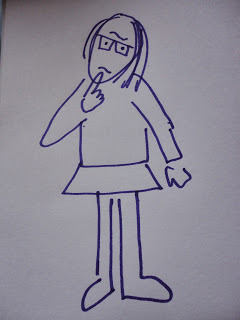 (That's meant to be an excited me, pretending to have to ponder on the question that actually has an obvious answer. Didn't quite turn out that way...)
(That's meant to be an excited me, pretending to have to ponder on the question that actually has an obvious answer. Didn't quite turn out that way...)[cue the page turn where everyone knows the answer and can shout it out loudly together:]
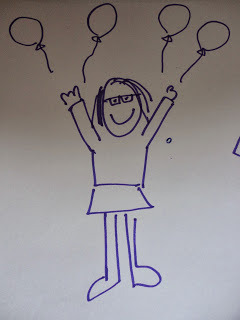 YES!
YES!Unusually, because this has been commissioned by BVT rather than a traditional publisher, we get to choose the angle and approach for the book and the design. At first, I thought we’d go down the route of fun historical book with lots of interesting facts and a mix of illustration, photos, letters etc.. There are some really interesting and fun books like that that we looked at:
 I've read Mandy Ross's Children's History of Birmingham over and over and it's great.
I've read Mandy Ross's Children's History of Birmingham over and over and it's great.(c) Mandy Ross, Hometown World.
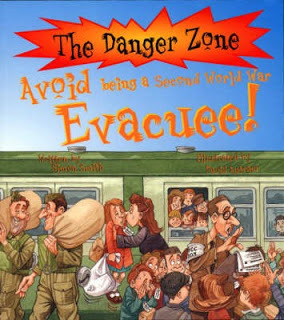 ...and we've really enjoyed the Avoid... books.
...and we've really enjoyed the Avoid... books. Avoid Being a Second World War Evacuee by Simon Smith, David Salariya and David Antram, Bookhouse.
I originally thought that our book might end up somewhat similar in format to these books.
But without thinking too much more about the structure, or indeed trying to impose in advance which story I’d try and tell, I got on with the research...

...and what an exciting area to research.
 (My walk up to the entrance, where the amazing archives are located.)
(My walk up to the entrance, where the amazing archives are located.)I immersed myself in the world of the Cadburys and chocolate.
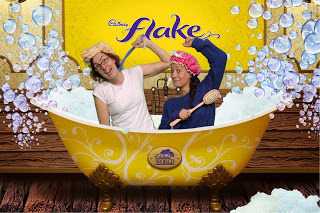
I’ve had amazing access to the archives and I’ve interviewed some fascinating people in their eighties and nineties, who used to work in the factory and whose families worked there well before. I’ve toured the Bournville Village Estate
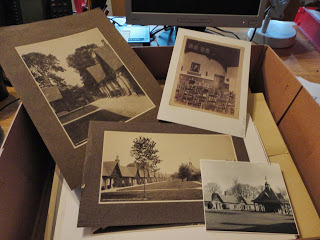 (Old photos of Bournville Village Trust. Copyright BVT)
(Old photos of Bournville Village Trust. Copyright BVT)and watched footage that’s over one hundred years old.
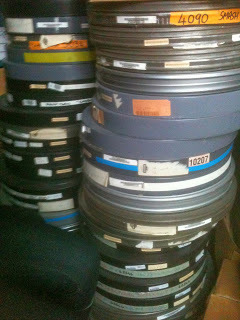
I’ve read letters and handwritten personal reminiscences about the 1880s
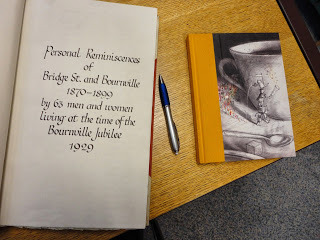 (c) Cadbury Archive
(c) Cadbury Archive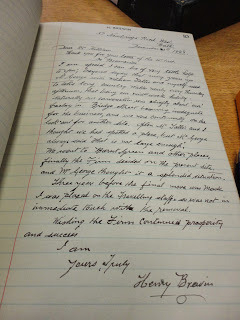 (c) Cadbury Archive
(c) Cadbury Archive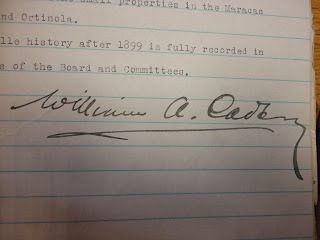 Recognise this signature and what it became? (c) Cadbury Archive
Recognise this signature and what it became? (c) Cadbury Archiveand I’ve got access to incredible photos...
But back to the structure –and creative nonfiction...
After a while of playing around with different ideas, Jess and I decided we’d like for it to be a real picture book, telling a real story. I got loads of nonfiction picture books out of the library. I found loads of information books that had lots of fascinating facts and that were really well written. But I didn’t find any beautiful ones that were telling a story. So I asked at the library if there were any they thought were really unusual, arresting, beautiful. The librarian came up with one that she felt was in a completely different league from the others. But we couldn’t find a copy anywhere. I kept asking what made it so special and she said, “you’ll know when you see it”. I reserved it but in the meantime, I couldn’t resist and I bought it, too.
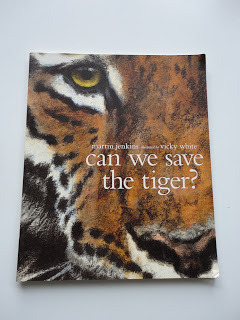 Can We Save The Tiger? by Martin Jenkins and Vicky White is indeed a beautiful book, which unusually for a nonfiction book, was shortlisted for the Kate Greenaway Award in 2012.
Can We Save The Tiger? by Martin Jenkins and Vicky White is indeed a beautiful book, which unusually for a nonfiction book, was shortlisted for the Kate Greenaway Award in 2012.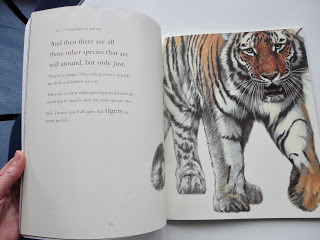 (c) Martin Jenkins and Vicky White, Walker Books
(c) Martin Jenkins and Vicky White, Walker BooksBut I couldn’t find any others –except one story we had at home that was first out in 1999:
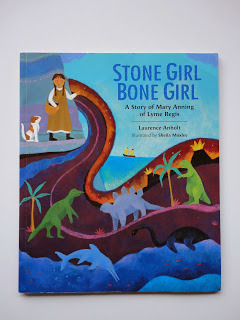 This beautiful book, Stone Girl, Bone Girl is about Mary Anning, the girl who inspired the popular children's tongue-twister She Sells Sea Shells on the Sea Shore (c)Laurence Anholt and Sheila Moxley, Frances Lincoln Books).
This beautiful book, Stone Girl, Bone Girl is about Mary Anning, the girl who inspired the popular children's tongue-twister She Sells Sea Shells on the Sea Shore (c)Laurence Anholt and Sheila Moxley, Frances Lincoln Books). 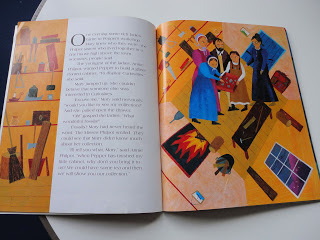 (c) Laurence Anholt and Sheila Moxley (Frances Lincoln Books)
(c) Laurence Anholt and Sheila Moxley (Frances Lincoln Books)And then someone from my fantastic online critique group (most of whom are American) posted up about WOW Nonficpic, an online nonfiction picture book forum and about an online course that was coming up, run by nonfiction picture book author, Kristin Fulton, which some of us might be interested in. And I feel like I entered into a new world of creative nonfiction that is much more common in the US than here in the UK. There was lots of talk about different, beautiful creative nonfiction picture books and my wish-list grew and grew...
I decided to do the four-week online course, where I was introduced to yet more beautiful creative nonfiction picture books.
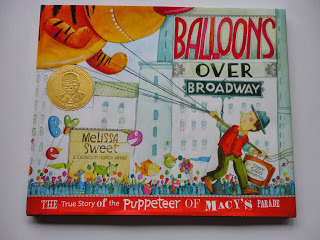 Balloons Over Broadway (c) Melissa Sweet, Houghton Mifflin
Balloons Over Broadway (c) Melissa Sweet, Houghton Mifflin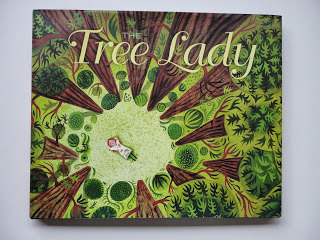 Tree Lady by H Joseph Hopkins, Beach Lane Books.
Tree Lady by H Joseph Hopkins, Beach Lane Books.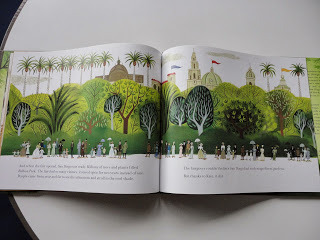 Tree Lady by H Joseph Hopkins, Beach Lane Books.
Tree Lady by H Joseph Hopkins, Beach Lane Books.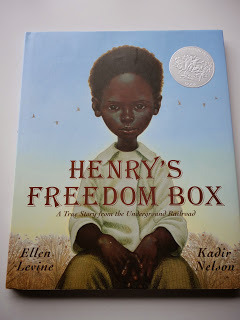 Henry's Freedom Box (c) Ellen Levine and Kadir Nelson, Scholastic Press
Henry's Freedom Box (c) Ellen Levine and Kadir Nelson, Scholastic PressI wanted to be immersed in a world of books that was new to me (and which there was little access to in the UK) and to be surrounded (virtually) by other people who were passionate about the form of creative nonfiction in the way that I’m so often surrounded by those writers who are passionate about picture books. The course was extremely good (I’d very seriously recommend it to anyone writing or interested in writing nonfiction picture books)–and timely for me. I’ve learned lots, and have now got hold of loads of books that I can use for inspiration (about completely different subjects). I’d already fallen in love with the research and the story for our book, but now I’d fallen in love with the form of book, too.
About four months after I’d starting researching the book, I decided which story I wanted to tell (the history is so fascinating I could have told lots). I spent weeks working on a picture book structure and testing it out with other writers.
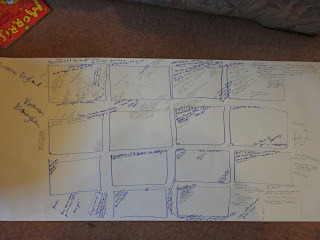
And I presented it to all the relevant people in Bournville earlier this week and it got the big thumbs up.
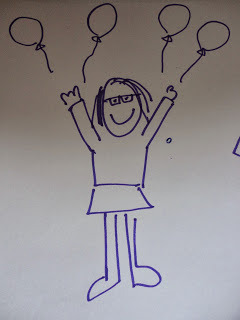
Creative nonfiction is very much like a fiction picture book. It’s about the story and the way you tell it; the use of page turns and the highs and lows. The expectation and surprise and like all good picture books, it needs to stand up to being read again and again. And the illustrations must be lovely, as with all good picture books.
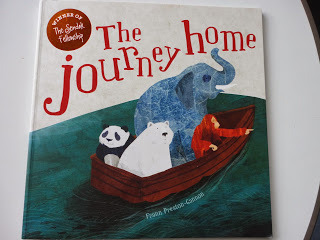 The very beautiful The Journey Home by Fran Preston-Gannon, Pavilion Books. It's not quite creative nonfiction but it's inspirational.
The very beautiful The Journey Home by Fran Preston-Gannon, Pavilion Books. It's not quite creative nonfiction but it's inspirational. (c) Fran Preston-Gannon, Pavilion Books.
(c) Fran Preston-Gannon, Pavilion Books.I’m so excited.
First, by the story –of two innovative young Quaker brothers...
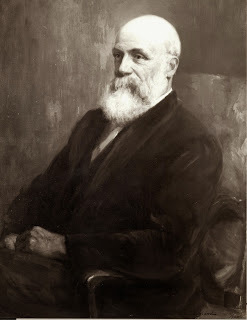 Richard Cadbury in later years (c) Cadbury Archive
Richard Cadbury in later years (c) Cadbury Archive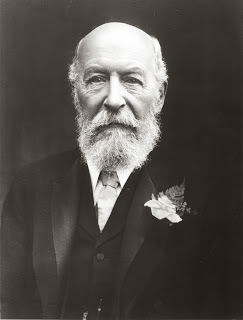 George Cadbury as an older man (c) Cadbury Archive
George Cadbury as an older man (c) Cadbury Archivewho did something remarkable. The death of their beloved mother had left their father
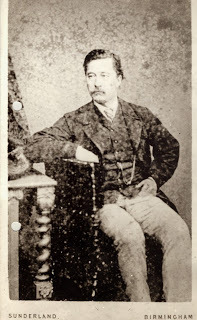 John Cadbury (c) Cadbury Archive
John Cadbury (c) Cadbury Archivea broken man and his cocoa factory and business was failing badly. With great integrity, humanity, sacrifice and an extraordinary vision, they took on the business, and turned it round to become incredibly successful throughout the world, whilst at the same time working to create much better working conditions,
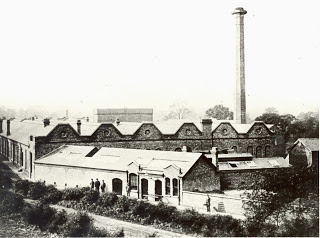 Bournville, the 'factory in a garden' 1879 (c) Cadbury Archive
Bournville, the 'factory in a garden' 1879 (c) Cadbury Archive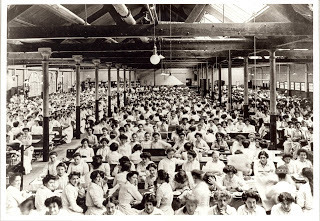 The girls' dining room (c) Cadbury Archive
The girls' dining room (c) Cadbury Archiveliving conditions
from this...
 Birmingham slums (c) Cadbury Archive
Birmingham slums (c) Cadbury Archiveto this...
 (c) Cadbury Archive
(c) Cadbury Archive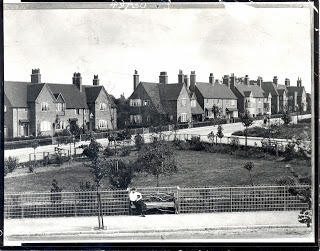 circa 1905 (c) Cadbury Archive
circa 1905 (c) Cadbury Archive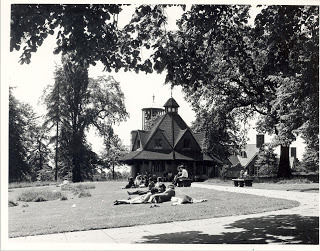 Bournville Green (c) Cadbury Archive
Bournville Green (c) Cadbury Archive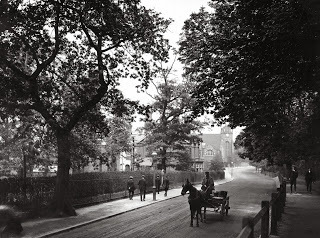 Early cottages built for the new model village (1905) (c) Cadbury Archive
Early cottages built for the new model village (1905) (c) Cadbury Archive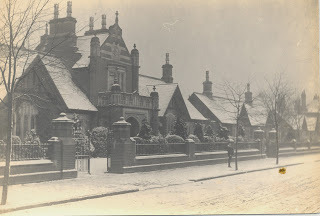 Almshouses for former factory workers, built by Richard Cadbury (c) Cadbury Archive
Almshouses for former factory workers, built by Richard Cadbury (c) Cadbury Archiveand spiritual and physical conditions for many thousands of people.
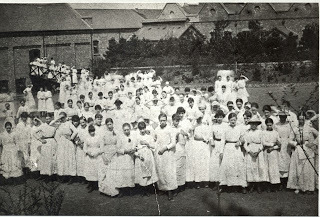
Early shot of girls at the factory (c) Cadbury Archive
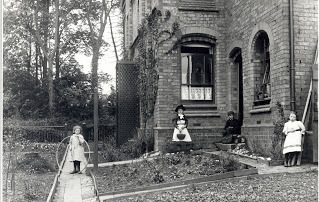 Early housing (c) Cadbury Archive
Early housing (c) Cadbury Archive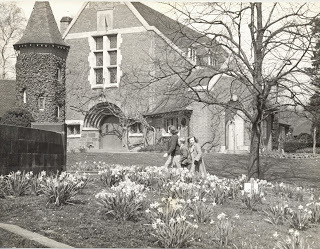 Bournville Friends Meeting House (c) Cadbury Archive
Bournville Friends Meeting House (c) Cadbury Archive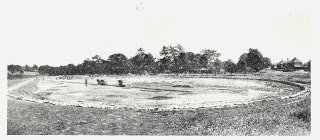 (c) Cadbury Archives
(c) Cadbury Archives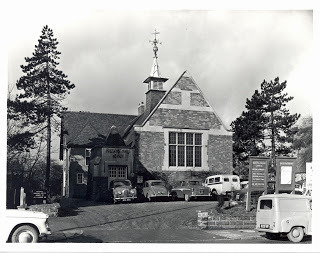 Friends Hall 1901 (c) Cadbury Archive
Friends Hall 1901 (c) Cadbury Archive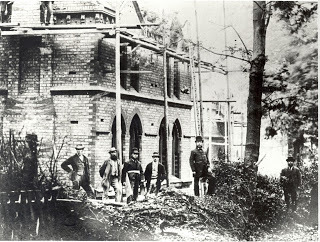 First Bournville cottages, 1880 (c) Cadbury Archive
First Bournville cottages, 1880 (c) Cadbury Archive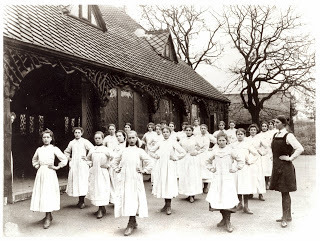 Girls' Physical Training Den, 1902 (c) Cadbury Archive
Girls' Physical Training Den, 1902 (c) Cadbury Archive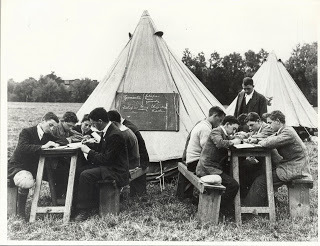 Camp school (or 'school on a barge') 1919 (c) Cadbury Archive
Camp school (or 'school on a barge') 1919 (c) Cadbury Archive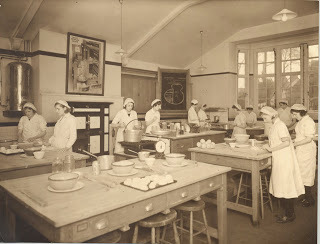 Day continuation school (c) Cadbury Archive
Day continuation school (c) Cadbury Archive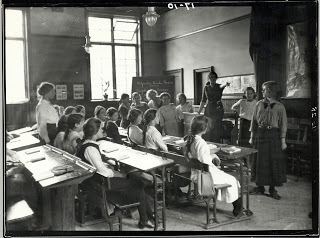 (c) Cadbury Archive
(c) Cadbury Archive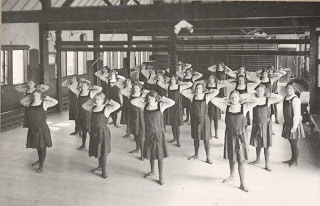 Girls' gymnastics, 1912 (c) Cadbury Archive
Girls' gymnastics, 1912 (c) Cadbury Archive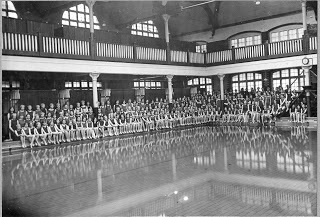 Swimming lessons, provided free during work time, 1910/1911 (c) Cadbury Archive
Swimming lessons, provided free during work time, 1910/1911 (c) Cadbury ArchiveBut I’m also really excited about having discovered creative nonfiction. I’ve got several other creative nonfiction books I’d really like to write after this one. I think that this love affair will go far...
I’ve spent so much of my time up at the factory archives, breathing in the sumptuous smell of chocolate as I get off the number 27 bus, I know I’m going to feel quite bereft when it’s over. It’s been like a dream job and I don’t want it to end.
But it’s time to get down to the actual writing now, bringing colour to the black and white, having made piles of notes over the past few months. The first really really rough draft will only take a couple of days to write as I know the story so well and I’ve got my structure sorted. Then I’ll spend the next couple of months playing with the language, fleshing it out and editing it.
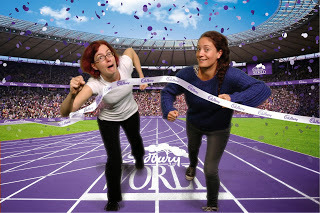 OK, we're not quite (?!) there, but we will be... once I've finished the text and Jess has illustrated it...
OK, we're not quite (?!) there, but we will be... once I've finished the text and Jess has illustrated it...As the wonderful David Almond said at a talk I went to last year:
“Make it lovely.”
And that’s what we plan to do.
What are your thoughts on creative nonfiction? Why are there so many more beautiful creative nonfiction picture books in the US than in the UK? Do UK publishers not feel there is a market for them? Are they there and I’m missing them? Or is there going to be the same explosion of these books in the UK in the coming years? I really hope so. Jess Mikhail and I are in an unusual position of being able to create what we most want to create, knowing that it will be produced and published (in conjunction with BVT), but it would be fantastic to see lots more on the shelves in schools, libraries and bookshops...
www.julietclarebell.com
Published on March 23, 2014 03:58
March 15, 2014
Picture Book Apps - Creating Good Screen Time

Today's welcome guest is Helen Dineen, a picture book author and mum of two living on the south coast of England. Helen signed with the Anne Clark Literary Agency last year and is hoping that 2014 is the year her stories might find a publisher. She also reviews book apps for young children at http://capptivatedkids.wordpress.com. Find her on Twitter @aitcheldee and @capptivatedkids
I've been blogging about kids' apps for nearly two years with my children (now aged 6 and 4) - as a parent rather than a writer. Back in 2011, I joined Twitter looking for publishers and authors to follow as I got more serious about writing my own stories. One of the first I followed was Kate Wilson, who was tweeting about Nosy Crow's very first app, The Three Little Pigs. As soon as I had an iPad I downloaded it and was instantly hooked. The Three Little Pigs showed me how good apps can be. Since then the explosion in story apps leading to the creation of the Interactive Stories section on the App Store shows there is a real market for them.
But books and apps are very different beasts. I couldn't find specific research on the use of book apps, so I conducted a very unscientific Twitter survey. 11 out of 12 replies counted book apps as screen time, and at least 9 out of 12 restricted their use with their children. One replied, " Nice way for kids to "read" on own, but we do limit all screen time... Always make time to read real books!" Only one did not distinguish between apps and books and added "I don't restrict time on them as we do anything to encourage reading."
With this in mind, I hope there will be increasing opportunities for picture book writers to write apps, while being confident that "real" books will not be abandoned by young children or their parents and carers any time soon.
What Apps Do Well
28% of 3-4 year olds use a tablet computer at home· Freedom from format constrictions such as number of pages and story structure. You can create a story with multiple pathways (Little Red Riding Hood, Sleepy Mole) or a circular life cycle story (Franklin Frog, Parker Penguin). · Have the reader change the story with their own suggestions (Don't Let the Pigeon Run This App uses the microphone for this).· Add atmosphere through narration, music and sound effects. · Add interactivity which draws the reader into the story e.g. solve a puzzle to reach the next page (Bartleby's Buttons) or show the reader reflected in a mirror using the iPad camera (Nosy Crow's Cinderella).
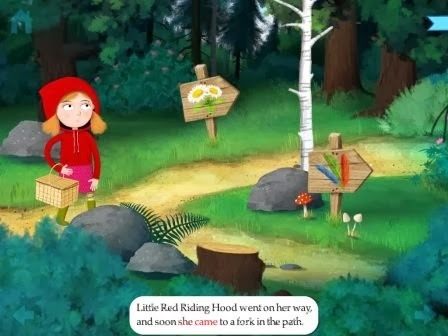 Little Red Riding Hood
Little Red Riding Hood
 Sleepy MoleThere's so much possibility out there that the most important bit - the story - can be drowned out. In an early blog post I compared apps to Powerpoint - remember those presentations which used every kind of slide transition and silly bits of clip art, just because they were there? But even when all the bells and whistles are used appropriately, too often I find myself wishing the story itself was stronger. And when the story is strong (perhaps based on an existing picture book) often the technology very little, perhaps just sound effects or animations. Which is why I think that...
Sleepy MoleThere's so much possibility out there that the most important bit - the story - can be drowned out. In an early blog post I compared apps to Powerpoint - remember those presentations which used every kind of slide transition and silly bits of clip art, just because they were there? But even when all the bells and whistles are used appropriately, too often I find myself wishing the story itself was stronger. And when the story is strong (perhaps based on an existing picture book) often the technology very little, perhaps just sound effects or animations. Which is why I think that...Apps Need Picture Book Authors!
I would love to see more established names producing original content with app developers (and I do think it is a shame Julia Donaldson could not be persuaded to take up the baton when Children's Laureate.) Original content produced specifically for the iPad is almost always better than transferring an existing picture book across. The interactivity can be developed alongside the story as one product rather than an add-on. Some aspects of existing books just don't work. To take one example, page turns often lose their impact when you have broken up the storytelling with interactivity. "And then he saw an ever so silly... [tap, tap, tap, make things move, after a few minutes turn the page] ...crocodile!" [wait, how did this sentence start again?]
I also think quality story apps can compete with games. Two parents responding to my Twitter survey said book apps count as "Good screen time". Another said " ...count them as screen time as they're often so interactive -to the point where [she] refers to them as games." Indeed the concern about apps replacing paper books is a distraction I think, from the wider issue of books losing out to TV, games and the internet as highlighted in BookTrust's latest reading habits survey. The more that reading can sneakily join up with gameplay in apps like Nosy Crow's Jack and the Beanstalk and Alph and Betty's Topsy-Turvy World, the better. I would also like to see more picture books connected to apps, providing extra content linking the two (see Moira's predictions in January).
I do think the opportunity is there to create more "good screen time." But I also think there are many ways in which picture books still have the edge.
 Alph and Betty's Topsy Turvy WorldWhere Picture Books Win
Alph and Betty's Topsy Turvy WorldWhere Picture Books WinIt is so easy to see a picture book on the shelf, pick it up and start reading! It is much easier to share a book at home, in preschool and with a class. If you spill juice on it, you've only lost one book. You can borrow piles of them from the library at a time for free. Let's face it, tablets are expensive and although many app developers provide video trailers so you can see what you are buying, you do still need to purchase every app you use. It's possible to gift an app, but not nearly as exciting for a small child with nothing to unwrap on their birthday.
When reading, the parent is better able to control the use of the book and pace of the story with a -book. Narration is the norm on apps - "When I use the iPad I don't read with them, I let them use it on read-to-me mode." This means the experience of reading a book is usually more shared with parents who spend time talking around the story more, doing all the silly voices, and getting involved in their children's world. You can touch and feel the pages, which can also be bigger - particularly good for large or detailed illustrations. You can't reproduce the impact of a huge, intricate double spread on an iPad!
And finally, using a book is easy. You turn the page, and read. When it comes to apps, there is no standard for activating page turns, turning narration on/off and so on. Every app is different, and children need to learn how they work. It isn't a big barrier for tech-savvy toddlers, but it is there.
The Future?
There are some great apps for this age group out there, and I hope more established picture book authors might get involved in writing original content and tapping in to the possibilities to merge storytelling and gameplay. But I don't believe technology will ever kill off picture books - books will wriggle up and make room for apps as they did for TV. In fact it may well be TV which loses out in the battle for children's attention. For this age group in particular it will be for parents to find the balance, and hopefully still choose to curl up with their child and a book or two.Want to find out more? Here are three of my favourites -· Little Red Riding Hood· Dragon Brush· The Monster at the End of This BookAnd see this great blog post by Kate Wilson on writing children's picture book apps.Go on, I'd love to see more fantastic digital content to read and blog about!
 Dragon Brush
Dragon Brush
Published on March 15, 2014 23:00
March 11, 2014
Kids have the Best Ideas by Jane Clarke
Kids have the best ideas
I'm in the middle of three hectic weeks of World Book Day visits to infant schools and nurseries. I love school visits - they keep me in touch with the age groups I write for and fire me with enthusiasm. And young children have such wonderful ideas…
Teddies are sliding down rainbows to swim with sharks,

floating around on balloons

and a fairy teddy is living in the stars.
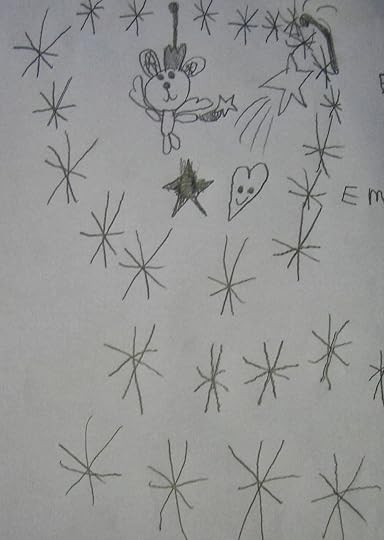
Creatures of all shapes and sizes are hatching out of eggs

and sometimes they make lovely pets

Gilbert (my great white shark) is starring in all sorts of new stories
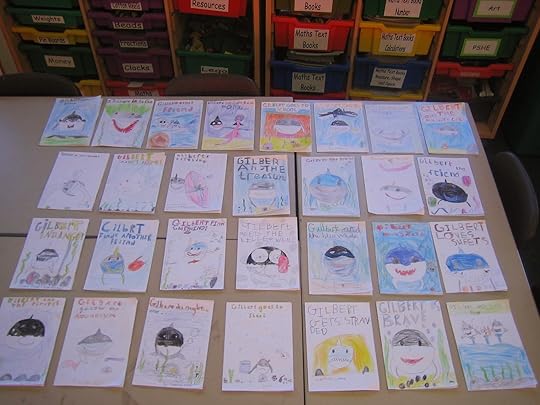
Castles are being discovered - this one's made of wood and visted by cloud dragons
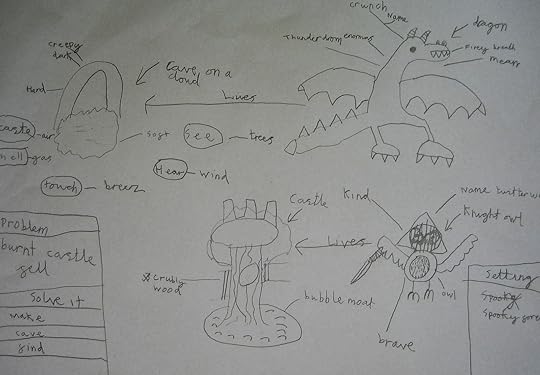
and this one's made of candy and populated with purple princess unicorns.

I'm having so much fun and I'm so impressed by the children's imaginations. Thanks to all the schools who have invited me to visit – and congratulations to all the young writers and illustrators out there!
Published on March 11, 2014 00:00



